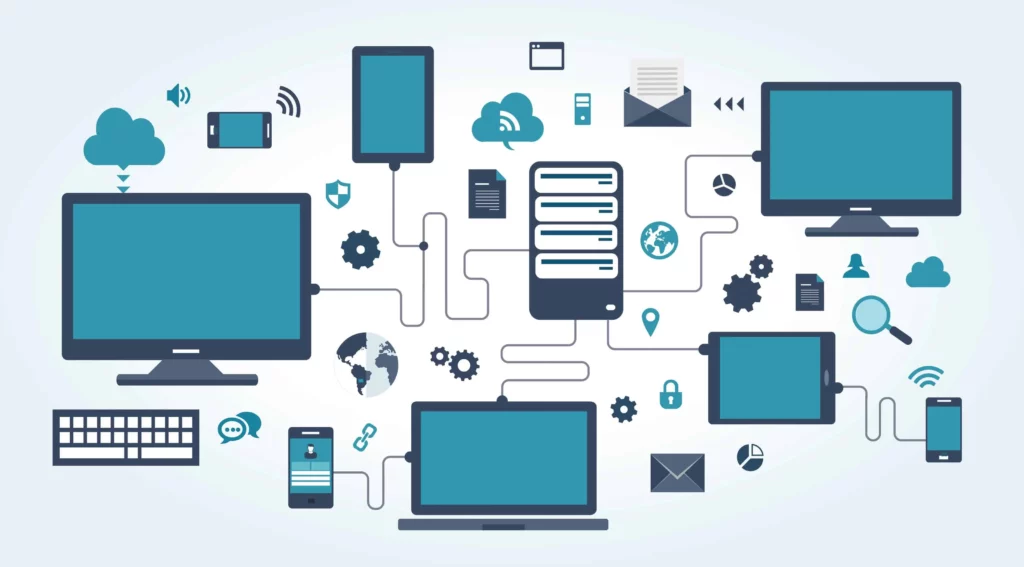In France, there is an average of 8 devices per user.
1. Therefore, the first thing to do is to equip yourself responsibly by :
- Extending the lifespan of equipment.
According to ADEME, extending the life of a computer from 2 to 4 years improves its environmental impact by 50%.
To keep equipment in good working order, it’s important to install anti-virus software and carry out regular updates. It’s also advisable to clean equipment and protect it from knocks and damage.
- Make sure you don’t buy systematically.
The manufacturing of new equipment requires an average of 50 to 350 times its weight in raw materials. The most important thing is to avoid replacing digital equipment unnecessarily, and to give priority to repair over replacement in the event of breakdown.
In over 50% of cases, end-of-life equipment could have been repaired.
It’s tempting to succumb to promotional offers and advertisements, but it’s important to make sure you know what you need before you buy.
- By identifying your needs and buying responsibly.
However, if equipment replacement is essential, it’s always possible to identify your needs and buy responsibly. The best way is to opt for an eco-responsible product. To do this, we recommend taking a close look at: manufacturing conditions, materials, environmental impact of manufacturing, recyclability, etc.
The materials used in the manufacturing of digital equipment are often minuscule in quantity, and their extraction costs an enormous amount of energy and resources for a disastrous yield. Their production also takes a heavy toll on the environment. All this comes at an ecological cost. The destruction of ecosystems, the excessive use of natural resources, the pollution of water, soil and air, and deforestation are just a few examples…
In addition, it’s best to choose a product with a label: TCO, Responsible Digital, Energy Star, EPEAT… and/or with a good reparability score.
Finally, it’s also possible to buy second-hand or reconditioned products.
2. The second gesture is to sort the waste of electrical and electronic equipment.
With the flow of waste electrical and electronic equipment increasing by 2% a year in Europe, it’s vital to have the reflex to sort waste.
In fact, 88% of French people change their cell phone while their old one is still working. This means that between 50 and 100 million phones are lying dormant in drawers. It is possible to resell unwanted devices (le bon coin, largusmobile.com, rachatdemobile, recycler.fr…) or donate them to resourceries or solidarity organizations: réseaux solidaires, ateliers du bocage, Envie network, Emmaus, troCantons…
You can also return old equipment to a manufacturer or retailer for appliances under 25 cm, or to a collection point for those over 25 cm.
- Waste must be taken to a waste disposal center.
3. The third gesture consists in limiting the energy consumption of electrical appliances by :
- Switching off appliances when not in use, or putting them on standby.
- Switching off your internet box at night or during the day when you’re away.
- Activating the energy-saving mode on your devices as often as possible, and switching to airplane mode when the device is not in use but remains switched on.
- Disabling Wifi, Bluetooth, GPS and data functions when not in use.
- Lowering screen brightness by default.
- Opting for the right connection: on PC, Ethernet cable first, then wifi. On tablets or smartphones, wifi rather than 4G.
- Protect devices from extreme temperature variations.
- Closing applications once they have been used.
4. Choose to use the Internet sparingly.
When browsing, this is made possible by :
- Limiting the number of unused programs or open tabs.
- Choosing your browser: Edge and Firefox are equal in terms of energy consumption, but Chrome is greedier.
- Measuring energy consumption in real time using the Carbonalyser extension created by The Shift project.
- Installing an ad blocker. Ads consume energy and bandwidth, and feed a consumerist logic.
When searching the Internet, this is made possible by :
- Using more keywords to reduce the number of results and pages consulted.
- Going directly to well-known sites rather than searching for URLs on search engines.
- Bookmarking the most visited sites.
- Using an eco-responsible search engine (e.g. Lilo, Ecosia).
- Avoid unnecessary data storage: regularly clean cache, cookies, history, downloads, etc.
- When streaming, this is made possible by :
- Preventing automatic video playback.
- Lowering video resolution.
- Favoring downloads over streaming.
- Listening to music as audio rather than video.
5. When using cloud solutions: content production and data storage by :
- Storing only the bare essentials on the cloud.
- Cleaning up your drive regularly.
- Choosing a ‘green’ hosting provider such as: Infomaniak, GreenGeeks, Kulo, Eco web hosting…
- Deleting unnecessary accounts.
- Protecting your data by preventing sites from collecting your personal information.
6. When using e-mail, by :
- Limiting the number of e-mails you send.
- Transferring large files via a sharing platform such as WeTransfer.
- Limiting the number of recipients.
- Reducing content, opting instead for text format.
- Deleting all unnecessary e-mails.
- Unsubscribing from unnecessary newsletters.
It is estimated that the rate of GHG emissions linked to the digital sector is equivalent to the aviation sector in 2023, and could reach the rate of emissions linked to the global car fleet in 2025.
Implementing a virtuous environmental policy to reduce the digital footprint is becoming increasingly urgent. It should be noted that this reduction is not just part of a downward spiral. It also leads to economic gains, as we move away from single-use products, imported from third countries and weighing on our trade balance, to a circular and much more sustainable model, offering reconditioned equipment and repair solutions. Public policies must continue to strongly encourage the sustainable creation of these jobs.
An article by Raja TRABELSI – PhD in carbon impact and environment – SAASWEDO



